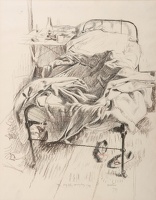
Robert Austin
My bed, rainy day, 1939


Interior scenes are often captivating because they reveal the artist’s intimate space and personal objects. Robert Austin depicts his unkempt bedroom on a rainy day, the display of unravelled blankets, disordered nightstand and slippers placed carelessly under the bed conjuring up a sense of time and space in the wake of the second world war. By contrast, Edward Halliday’s portrayal of the Prime-Minister’s house in New Delhi communicates a different sensibility – that of order and wealth. Diverse activities are taking place in some of the scenes, such as a game of charades at Barnett Freedman’s house, sewing in Edith Granger Taylor’s The Pink Armchair or reading in Charles Mahoney’s Portrait of Geoffrey Rhoades. Others are empty rooms, giving the appearance of carefully orchestrated still-lives, such as Finney’s Room Overlooking the Sea or Charles Burleigh’s Still life in the Artist’s Studio. Herbert James Gunn, however, paints himself directly into the scene, portraying himself as an artist languishing in Stygian gloom – striking a pose between melancholia and heroic patriotism, the walls of his studio subtly disappearing into the background.
 sold
sold  reserved
reserved  private collection
private collection